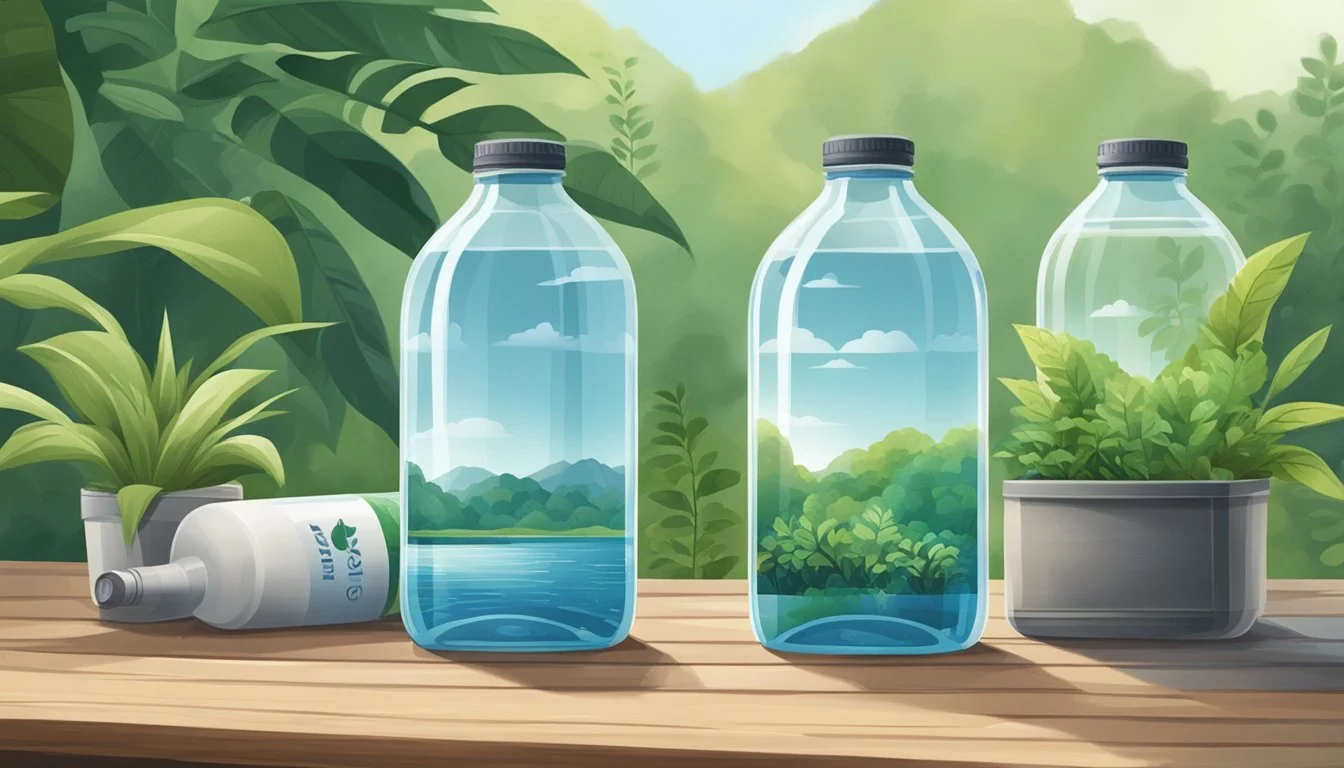Castle Rock vs. Kroger
Which Bottled Water is Better for You?
When it comes to choosing bottled water, consumers often find themselves deciding between brands like Castle Rock and Kroger. Both brands have their own loyal followings and unique characteristics. For those seeking a balance of safety, environmental consideration, and taste, Castle Rock generally holds a slight edge over Kroger.
Castle Rock bottled water is known for its purity and commitment to environmental sustainability. It sources its water from pristine, natural springs and adheres to rigorous quality standards, which tend to resonate well with eco-conscious consumers. On the other hand, Kroger bottled water, while meeting FDA regulations and often available at a lower price, has faced criticism regarding pollutants such as microplastics and environmental impacts from plastic waste.
Despite these concerns, many still choose Kroger for its convenience and affordability. Its widespread availability and reputation for meeting basic safety standards make it a popular choice among budget-conscious shoppers. Whether prioritizing environmental impact, taste, or cost, understanding the differences between Castle Rock and Kroger can significantly influence your bottled water preferences.
Understanding Bottled Water
Bottled water comes in various types, each with distinct characteristics and origin. These types range from natural spring water to purified water, each offering different benefits based on the source and additional elements like minerals and electrolytes.
Types of Bottled Water
Natural Spring Water: Sourced from natural springs, this type of water is rich in minerals and typically bottled at the source. Spring water often contains naturally occurring electrolytes, which can enhance hydration.
Purified Water: This type has undergone a process to remove impurities and contaminants. Methods include distillation, deionization, and reverse osmosis. Purified water can start from any source, including groundwater or even tap water. The goal is to achieve high purity, with a neutral pH level.
Mineral Water: Contains naturally occurring minerals from its source. Unlike spring water, it must have a constant level of minerals such as calcium, magnesium, and sodium. This water is often marketed for its health benefits due to its mineral content.
Electrolyte Water: Enhanced with added electrolytes like potassium and sodium to improve hydration and support bodily functions. Often targeted toward athletes or those needing quick replenishment of essential minerals.
Alkaline Water: Has a higher pH level, usually above 7. This water is believed by some to neutralize acid in the bloodstream, although scientific evidence supporting these health benefits is limited. Often created through a filtration process that adds minerals to increase the pH.
Source and Origin of Bottled Water
Natural Spring: Water that flows naturally to the surface from a protected underground source. Many spring waters originate from mountain springs and are bottled at the source to retain their natural qualities.
Groundwater: Tapped from underground aquifers or wells, groundwater can be treated to remove impurities. This water is common for purified bottled water.
Mountain Spring Water: Typically sourced from high-altitude springs, this type of water often claims to be exceptionally pure due to its remote origin. It usually goes through minimal filtration to maintain its natural state.
Municipal Source: Some bottled waters originate as tap water from municipal systems. These undergo additional purification processes to meet quality standards. Despite starting from a common source, the treatment processes can significantly alter the final product's taste and purity.
Understanding these distinctions helps in choosing bottled water that aligns with personal preferences and health needs.
Health and Hydration
When comparing Castle Rock and Kroger bottled water, it is crucial to understand their impact on health and hydration. The benefits of adequate hydration, potential health implications of water quality, and the presence of essential electrolytes and minerals play a significant role.
Benefits of Hydration
Hydration is fundamental for maintaining bodily functions. Water regulates body temperature, lubricates joints, and aids digestion. Both Castle Rock and Kroger bottled water serve as reliable sources for daily hydration needs. Proper hydration prevents dehydration, which can cause headaches, fatigue, and impaired concentration.
Drinking adequate amounts of water supports kidney function by flushing out toxins. For athletes and active individuals, maintaining proper hydration helps enhance performance and recovery. Staying hydrated also keeps skin healthy and reduces the risk of urinary tract infections.
Health Implications of Water Quality
The quality of bottled water affects health outcomes. Castle Rock bottled water is sourced from natural springs and undergoes minimal processing, preserving its natural minerals. Kroger bottled water adheres to FDA regulations, ensuring safety, but concerns over contaminants like microplastics exist.
Water quality impacts taste and health benefits. High-quality water should be free from harmful substances like lead, chlorine, and bacteria. Consumers should check for third-party certifications like NSF or EPA to verify water quality. Bottled water with a balanced pH and low levels of contaminants is healthier for daily consumption.
Electrolytes and Minerals
Electrolytes like calcium, potassium, and magnesium are essential for bodily functions. Castle Rock water often contains natural minerals due to its spring source. These include calcium and magnesium, which support bone health and muscle function.
Kroger water may not always advertise added electrolytes, but it can still contribute to daily mineral intake. Electrolytes help maintain fluid balance, nerve function, and muscle contractions. Checking the label for mineral content ensures consumers are informed about the nutritional benefits.
Optimal mineral and electrolyte levels enhance hydration efficiency. Water with balanced electrolytes can prevent cramping and improve overall physical performance.
Safety and Purity Standards
Bottled water safety and purity are critical for consumers concerned about contaminants and chemicals. The following sections will cover regulations, testing methods, and quality certifications to compare Castle Rock and Kroger bottled water.
FDA Regulations and Guidelines
Bottled water in the United States must adhere to strict FDA regulations and guidelines. Both Castle Rock and Kroger are required to meet these standards, ensuring their water is clean and safe for consumption. The FDA sets limits for contaminants, including lead and chemicals, based on Environmental Protection Agency (EPA) criteria for tap water.
Castle Rock sources its water from natural springs and uses filtration methods such as reverse osmosis. Kroger, often sourcing from municipal locations, adheres to these guidelines to maintain compliance. The FDA inspections help ensure that labeling is accurate, preventing misrepresentation of water quality.
Testing for Contaminants and Chemicals
Testing for contaminants is a major aspect of bottled water safety. Castle Rock utilizes comprehensive testing processes to detect microplastics, chemicals, and other pollutants. They often publish their water quality reports, detailing the absence or extremely low levels of harmful substances.
Kroger conducts routine testing to identify contaminants. Consumer Reports highlighted PFAS chemicals found in some bottled water brands, including those similar to Kroger. Testing includes evaluating the presence of caffeine, acetaminophen, and plastic-derived chemicals. Both brands aim to limit contaminants through advanced filtration technologies.
Quality Reports and Certifications
Quality reports and independent certifications underscore bottled water's safety and purity. Castle Rock often showcases its results through third-party verifications and aligns with standards set by organizations like the International Bottled Water Association (IBWA) and the Environmental Working Group (EWG).
Kroger also provides water quality reports, often conducted by independent labs. These reports include details about filtration methods, contaminant levels, and compliance with FDA and EPA standards. Certifications and audits from regulated agencies ensure both Castle Rock and Kroger maintain high standards in their products, leading to safer bottled water choices for consumers.
Both brands adhere to stringent regulations and guidelines to ensure the safety and purity of the bottled water. Understanding their commitment to exceeding these standards provides consumers with the confidence needed to make informed choices.
Taste Profile Comparison
Comparing the taste profiles of Castle Rock and Kroger bottled waters reveals variations influenced by their sources and mineral compositions. Factors such as mineral content and pH level significantly affect the flavor, making each water unique on the palate.
Factors Affecting Water Taste
Water taste is influenced primarily by its mineral content. Minerals such as calcium, magnesium, and potassium can contribute to a water's flavor profile. Water with a high mineral content often has a more complex taste, while low-mineral water tends to be more neutral and clean.
The pH level also plays a role. Water with a neutral pH around 7 is generally preferred, while acidic or alkaline water may have distinctive flavors. Other factors include the source of the water, whether it comes from a spring, glacier, or tap, and any treatment processes it undergoes.
Water sommeliers attest that the terroir, or environmental characteristics of the source, can lend unique flavors. For instance, spring water might have earthy, sweet nuances, whereas glacier water could be more crisp and refreshing.
Castle Rock vs. Kroger Taste Test
A direct taste comparison between Castle Rock and Kroger bottled waters shows notable differences. Castle Rock water is often praised for its crisp, refreshing taste. It derives its flavor from high mineral content and a near-neutral pH, contributing to a balanced palate experience. Consumers often describe it as clean and invigorating.
Kroger's bottled water, in contrast, has a more neutral taste. It contains fewer minerals, leading to a simpler, more straightforward flavor. This can be preferable for those who seek a clean, unobtrusive taste without any mineral aftertaste.
In taste tests, participants have highlighted Castle Rock's slightly sweet, mineral-rich flavor. Conversely, Kroger’s unobtrusive water profile makes it versatile for everyday consumption, often favored by those who prefer a less pronounced taste.
The differences in taste profiles of these two brands underline the importance of personal preference in choosing bottled water.
Environmental Considerations
When evaluating Castle Rock and Kroger bottled water, it's essential to consider their environmental impact and sustainability efforts. Both brands face challenges related to plastic bottles and brand responsibility, but their approaches may influence consumer choices significantly.
Impact of Plastic Bottles
Plastic bottles are a major concern due to their environmental footprint. Kroger's bottled water, like many others, often uses plastic containers that contribute to pollution and waste. Plastic waste can end up in oceans and landfills, taking hundreds of years to decompose.
BPA (Bisphenol A), a chemical found in some plastics, has health and environmental concerns. Kroger has moved towards BPA-free bottles to mitigate these issues. Despite this, the problem of microplastics persists, potentially affecting both human health and marine ecosystems.
Castle Rock, on the other hand, markets itself as an environmentally friendly brand, using 100% recycled plastic bottles. This reduces waste and the need for new plastic production. By promoting recycling and reusability, Castle Rock aims to minimize its environmental impact.
Sustainable Practices and Brand Responsibility
Both Castle Rock and Kroger are aware of their environmental responsibilities. Kroger adheres to FDA regulations, ensuring safety and quality, but their broader environmental strategies include reducing plastic usage and improving recycling initiatives.
Castle Rock stands out with its sustainability commitment. The brand focuses on eco-friendly practices like using recycled materials, reducing carbon footprints, and sourcing water responsibly. This approach enhances their brand image among eco-conscious consumers.
Kroger has also begun to adopt sustainable practices, although their progress is more gradual. Efforts include exploring alternatives to plastic bottles and improving their environmental impact through various green initiatives.
In summary, while both brands are making strides toward better environmental practices, Castle Rock leads with its strong focus on sustainability and recycled materials. Kroger shows potential through gradual improvements, particularly in reducing BPA and encouraging better recycling habits.
Brand Analysis and Manufacturing Processes
Castle Rock and Kroger bottled waters use different approaches in their manufacturing and purification processes, affecting their taste, safety, and overall quality. Castle Rock focuses on natural purification, while Kroger employs modern purification methods to meet safety standards.
Purification Methods and Techniques
Castle Rock employs natural spring water sourced directly from protected springs. Their process emphasizes minimal intervention, often using natural filtration through rock and soil. This method preserves the water’s mineral content, contributing to its distinct taste and potential health benefits.
Kroger, by contrast, uses a more industrial approach. Their bottled water typically undergoes rigorous purification techniques like reverse osmosis, ultraviolet light treatment, and carbon filtering. These methods ensure the elimination of microorganisms and contaminants but may strip away beneficial minerals, leading to a more neutral taste profile.
These differences in purification processes influence not only the water’s composition but also consumer preferences based on taste and perceived health benefits.
Packaging and Brand Positioning
Castle Rock markets itself as a premium brand, emphasizing its natural source and eco-friendly packaging. They often use glass bottles and promote the sustainability of their product. This aligns with a segment of consumers who prioritize environmental impact and natural sources in their purchasing decisions.
Kroger focuses on affordability and accessibility, using plastic bottles to ensure lower costs and wide distribution. While addressing consumer concerns about plastic, many of their bottles are now BPA-free. Kroger’s branding leans on FDA compliance and safety standards, which reassures consumers looking for reliably clean and safe hydration at an affordable price.
These packaging choices and brand strategies reflect the distinct market positions of Castle Rock as a high-end option and Kroger as a cost-effective alternative. Their respective approaches highlight their targeted consumer base and commitment to different aspects of quality and sustainability.
Consumer Experience and Accessibility
When comparing Castle Rock and Kroger bottled water, consumers often consider availability in stores and pricing, as well as their loyalty to each brand and personal preferences.
Availability and Pricing
Kroger bottled water is widely available in numerous grocery stores and supermarket chains across the country. Its price point is generally inexpensive, making it an easy choice for budget-conscious consumers.
Castle Rock water, while available, is not as omnipresent as Kroger. This premium water is often found in specialty health food stores and select online retailers, usually at a higher price.
For many, the convenience of finding Kroger water during a routine grocery run adds to its appeal. Meanwhile, Castle Rock’s distribution is more limited, thus impacting its accessibility.
Brand Loyalty and Consumer Preferences
Brand loyalty significantly influences consumer choices between these two waters. Kroger, being a well-known grocery brand, benefits from a broad customer base that trusts its products for their routine needs.
Castle Rock, known for its higher-quality sourcing and unique mineral content, attracts a niche group of consumers who prioritize premium water quality over cost and availability.
Preferences also hinge on taste and perceived health benefits. Some consumers appreciate Kroger for its neutrality and affordability. Others prefer Castle Rock for its distinct taste and reputed health benefits. Each brand thus caters to different market segments, based on what consumers value most in their drinking water.
Comparison of Additional Brands and Alternatives
When considering alternatives to Castle Rock and Kroger, it's important to explore the characteristics of other popular bottled water brands, focusing on their sources, flavors, and perceived quality.
Comparative Analysis
Essentia
Essentia water boasts an ionized alkaline composition with a pH of 9.5, which appeals to those seeking hydration with potential health benefits. The advanced purification process ensures a clean, smooth taste.
Fiji
Fiji water, sourced from an underground aquifer in Viti Levu, Fiji, is known for its soft mouthfeel and natural mineral content. Its silica concentration gives it a unique, smooth texture.
Evian
Evian water originates from the French Alps and offers a balanced mineral composition. Its naturally occurring electrolytes contribute to a distinct, crisp taste, making it a premium choice.
Dasani
Dasani, produced by The Coca-Cola Company, undergoes a rigorous purification process. While accessible and affordable, it doesn't feature notable mineral content, resulting in a neutral taste.
Aquafina
Aquafina, PepsiCo's flagship water, shares similarities with Dasani. It is widely available and purified extensively, but it lacks distinctive mineral characteristics.
Smartwater
Smartwater, vapor-distilled with added electrolytes, provides a clean, crisp taste. The inclusion of electrolytes is aimed at promoting optimal hydration.
Voss
Voss water, sourced from Norway, is characterized by its purity and minimal mineral content, delivering a clear and refreshing taste. Its distinctive glass bottle adds a touch of luxury.
Core Hydration
Core Hydration water is ultra-purified and balanced to a pH of 7.4, aiming to match the body's natural pH. It is marketed as providing balanced hydration and a smooth taste profile.
Poland Spring
Poland Spring, sourced from Maine, USA, offers natural spring water with a crisp, clean taste. Its widespread availability makes it a convenient option.
LIFEWTR
LIFEWTR is purified and pH-balanced, often featuring creative bottle artwork. It targets health-conscious individuals and focuses on delivering a refreshing hydration experience.
The Bottom Line: Choosing Your Water
When choosing between Castle Rock and Kroger bottled water, several factors come into play.
Castle Rock water is sourced from the pristine springs in California. It often ranks high due to its consistent quality and natural taste. Many consumers appreciate its eco-friendly packaging and commitment to sustainability.
Kroger bottled water adheres to strict FDA regulations. While it meets safety standards, concerns over microplastics and BPA still exist. Kroger's affordability and widespread availability make it a popular choice for everyday use.
Aspect Castle Rock Kroger Source Natural Springs Various, including municipal Quality High Regulated, varied Packaging Eco-friendly options BPA-free options Taste Pure, natural Clean, neutral Environmental Impact Lower Significant Cost Higher Affordable Availability Select regions Nationwide
Castle Rock is ideal for those prioritizing natural sources and environmental impact. Kroger suits budget-conscious consumers needing a reliable water option. Both have their strengths, catering to different preferences and priorities.






